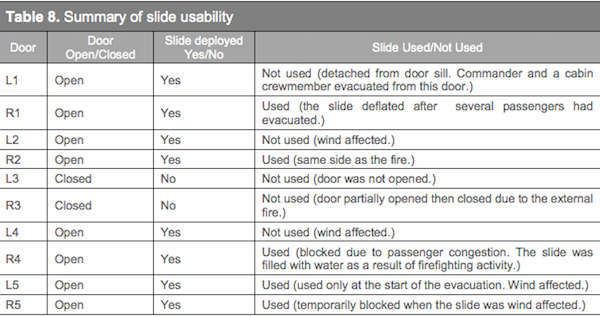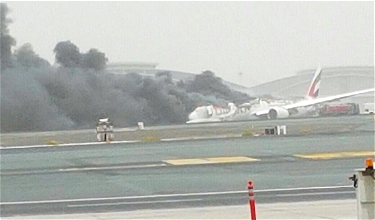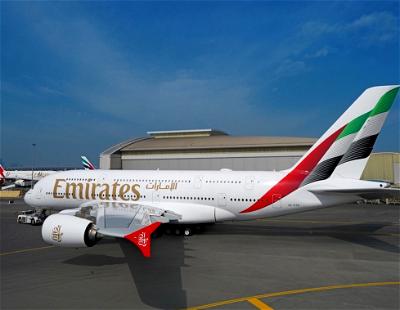In early August, an Emirates 777 crash landed in Dubai. While there has been a lot of speculation as to what happened, up until now we haven’t received much official information.
Emirates Boeing 777 on fire at #Dubai parts of fuselage broken off: appears to be #EK521 from Thiruvananthapuram. pic.twitter.com/sJS0y7vNk3
— Alex Macheras (@AlexInAir) August 3, 2016
Well, the General Civil Aviation Authority of the UAE has released a preliminary report of what happened to EK521 as it came in to land at Dubai International Airport. This is a preliminary report, meaning it doesn’t draw any conclusions as to the cause of the crash, but rather reports on all the facts we know as of now.
As usual, the preliminary report is highly technical and 28 pages long, so the average person won’t understand much of what’s explained in the report. However, it’s a very interesting read nonetheless.
Big picture, what happened was that the plane landed “long,” about 1,100 meters down the runway, partly caused by a change in the winds as the plane approached.
The plane had full flaps and idle power as it touched down, though due to the warning system saying that the plane landed long, the pilots decided to execute a go around. That’s where things got messed up.
The plane climbed to an altitude of 85 feet and the pilots had already retracted the plane’s gear and raised the flaps, though the plane didn’t have a positive rate of climb. At that point the plane began to sink.
We don’t know whether the pilots tried to activate the “take off/go around” switch or not, though regardless it apparently doesn’t work on a Boeing once the gear makes contact with the ground (which matches a past theory we’ve heard about what happened).
While the evacuation was successful (all passengers got out safely, though unfortunately one of the firefighters died during the rescue efforts), it’s amazing that this was done in spite of major problems with the evacuation. The 777-300 has 10 emergency exits. Only five of the 10 emergency exits were ever used, and of the five used, some of them had problems beyond that, as you can see in the below chart:

On top of that, passengers stupidly took their personal belongings with them, which slowed down the evacuation process further, putting peoples’ lives at risk.
While totally random, it’s interesting to note that the captain was younger and had fewer hours than the first officer (which isn’t unusual at Emirates, as the captain was a “local,” while the first officer was Australian):

I’m not suggesting that had anything to do with the accident, as both pilots were pretty experienced. Rather I was just impressed that the 777 captain was just 34 — that’s impressive!
Bottom line
What we know for sure is that EK521 crashed due to a go around gone wrong. The winds changed during the landing, which caused the pilots to make a “long” landing and then decide to go around. Unfortunately the plane stalled as it tried to climb out, though it remains to be seen how exactly that mistake occurred.





Stick to premium travel related perspectives. It's fairly obvious that an "average person won’t understand much of what’s explained in the report" based on your interpretation of the evidence.
There are alternative approaches to TO/GA and while some insist that the TO/GA is deactivated upon sensors on the landing gear strain gauges, it is common for pilots to reacquire control and perform TO/GA by themselves. This is a fairly complex event and the preliminary report,...
Stick to premium travel related perspectives. It's fairly obvious that an "average person won’t understand much of what’s explained in the report" based on your interpretation of the evidence.
There are alternative approaches to TO/GA and while some insist that the TO/GA is deactivated upon sensors on the landing gear strain gauges, it is common for pilots to reacquire control and perform TO/GA by themselves. This is a fairly complex event and the preliminary report, which I read, only reveals more questions than answers.
Not sure what there is to say about this other than the incident was caused by ABSOLUTELY POOR airmanship. No change in wind should cause a 3,000+ foot long landing and monitoring speed is essentially the most important part of any GA procedure. No speed = no lift. The utter incompetence shown by those two pilots is enough to have me question the safety culture of the entire airline. I won't fly OZ and AF...
Not sure what there is to say about this other than the incident was caused by ABSOLUTELY POOR airmanship. No change in wind should cause a 3,000+ foot long landing and monitoring speed is essentially the most important part of any GA procedure. No speed = no lift. The utter incompetence shown by those two pilots is enough to have me question the safety culture of the entire airline. I won't fly OZ and AF for the same reason...sounds like EK may need to be added.
If pilots cannot execute a common occurrence procedure like "GA" and "pitch and power", I am not going to sit myself or my family on one of their flights. Because it is only a matter of time until you'll be on one of their flights where this will need to be executed.
I'd rather endure 10 hours of flying on a substandard product airline like AA or UA.
Hello Lucky,
You may want to red these blog posts from a pilot (I'm sure you know of him) about differences between Pilot and Co-Pilot/First Officer :
www.askthepilot.com/questionanswers/seniority/
www.askthepilot.com/pilots-and-copilots/
It has been reported that the recertification instructors keep stressing that all "auto pilot" commands are disabled once the wheel sensors detect touchdown. Therefore, it isn't enough to just press the TO/GA switch, the PF/PNF has to manually shift the throttle to full thrust. Maybe the pilot flying wasn't paying attention, or he forgot the operating manual.
Once they heard the "Long Landing" call and decided on a GA at such low altitude, the...
It has been reported that the recertification instructors keep stressing that all "auto pilot" commands are disabled once the wheel sensors detect touchdown. Therefore, it isn't enough to just press the TO/GA switch, the PF/PNF has to manually shift the throttle to full thrust. Maybe the pilot flying wasn't paying attention, or he forgot the operating manual.
Once they heard the "Long Landing" call and decided on a GA at such low altitude, the PF should have taken over manual controls.
This seems to be a combination of three compounded errors by the PF and PNF.
1. Even with a long landing, there was enough runway left to land the plane safely. There was no need to go around.
2. Once the PF decided to go around after touchdown, he just pressed the TO/GA switch expecting the Flight Director to take over the thrust management. Neither the PF or the PNF seems to have had a hand on the throttle to manually over ride if necessary.
3. It took them a full 12 seconds after the TO/GA switch press to realize the Flight Director hadn't increased the thrust, by which time it was too late.
At 0837:35, three seconds before impact with the runway, both thrust levers were moved from the idle position to full forward.
Pilot error.
All the rest is BS.
The continuous accusations that passengers are making a rational decision to bring their bags with them while in a life and death situation (I.e. Stressful) are just as stupid as the act of bringing the bags in the first place...
I dont doubt a couple do, but anyone with a tenuous grasp on human psychology could easily see that's not necessarily the case for most.
I'm more interested in the deflated slide given how many people were bringing carryons with them. Does the report note the cause of the deflation?
Damn... You commenters are salty AF!
Want to come work as AA crew?
Typical, you don't even bother reading the whole report. The pilot has more hours on this aircraft - more than double. Yet you don't mention that. Instead you talk about how a pilot three years younger than the copilot has a few hundred hours more flying. Which you'd expect if one is 3 years older.
Typical crap blogging
I live in Dubai and I have several friends whom are pilots and some have been promoted captain recently. Due to a huge need for pilots, Emirates promotes captains pretty fast. Some of them after three years from joining. Some after five. But I know several captains who are 35 (and I am not talking of Emiratis) so I wouldn't be surprised to know that one was just 34.
Emirates standards are still pretty much...
I live in Dubai and I have several friends whom are pilots and some have been promoted captain recently. Due to a huge need for pilots, Emirates promotes captains pretty fast. Some of them after three years from joining. Some after five. But I know several captains who are 35 (and I am not talking of Emiratis) so I wouldn't be surprised to know that one was just 34.
Emirates standards are still pretty much high. A year ago I read an article that placed EK as the second safest airline after Qantas.
Lucky -
The problem is that the facts don't actually support an implication that he received preferential promotion, other than the fact that he almost certainly came up through the EK cadet pilot program (which historically was reserved for "locals"). No way someone gets nearly 70% of their TT in a widebody without be part of an ab initio program.
You're looking at the wrong hours to draw your conclusion - you should be...
Lucky -
The problem is that the facts don't actually support an implication that he received preferential promotion, other than the fact that he almost certainly came up through the EK cadet pilot program (which historically was reserved for "locals"). No way someone gets nearly 70% of their TT in a widebody without be part of an ab initio program.
You're looking at the wrong hours to draw your conclusion - you should be looking at the time on type. Given that the FO only currently has a 777 type rating, his time on type (1296 hrs) probably tells you something how many hours he has flown for EK. We have no idea where his other hours came from. For instance, 4000 could be on a twin prop or a Cessna 172.
Comparing 5128 to 1296 hrs on type, the captain was clearly far more senior at EK, and implications otherwise aren't really supportable by the facts. We'll need to see a more comprehensive accident report to potentially get more details about their experience.
Greg
Not good reporting lucky , trying to imply the captain was captain due to citizenship ..
@ Sean -- To be clear, I wasn't suggesting that either pilot wasn't experienced, as both have a substantial number of hours. That being said, preferential promotions for Emiratis at Emirates is a known thing. That's not some kind of conspiracy theory, but a fact. I'm not saying that had anything to do with the accident -- it certainly didn't. I just saw that the report had their ages and hours listed, and was impressed...
@ Sean -- To be clear, I wasn't suggesting that either pilot wasn't experienced, as both have a substantial number of hours. That being said, preferential promotions for Emiratis at Emirates is a known thing. That's not some kind of conspiracy theory, but a fact. I'm not saying that had anything to do with the accident -- it certainly didn't. I just saw that the report had their ages and hours listed, and was impressed that the captain was just 34. That's pretty young for a 777 captain (good for him).
It has nothing to do with the Captain being Emirati; the Captain has 5,000+ hours on the 777, while the F/O only has 1,300 hrs.
Lucky -
Thanks for posting this. Interesting, and again the mass stupidity of many passengers in an evacuation is stunning, especially in something like this, which is unquestionably a life-threatening emergency.
One comment, though - you noted the relative ages and total time of the captain and the first officer, implying that it was because the captain was a "local." That may be, but you overlooked an important point - according to the chart,...
Lucky -
Thanks for posting this. Interesting, and again the mass stupidity of many passengers in an evacuation is stunning, especially in something like this, which is unquestionably a life-threatening emergency.
One comment, though - you noted the relative ages and total time of the captain and the first officer, implying that it was because the captain was a "local." That may be, but you overlooked an important point - according to the chart, the captain had nearly 4 times the number of hours in the 777 type than the FO.
That said, it was the captain who munged up the landing, so casting aspersions on the piloting skills of the captain is probably appropriate...